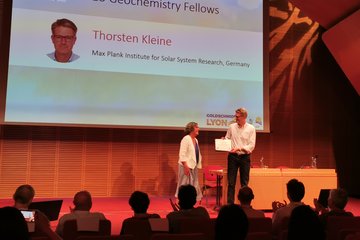Alle Typen
81.
Konferenzbeitrag
Energetic particles in the heliosphere. In: Conference Proceedings ``Solar System Plasma Physics'', S. 111 - 136 (Hg. Mariani, F.; Ness, N. F.). SIF, Bologna (1997)
82.
Konferenzbeitrag
Search for the origin of quiet-time particle fluxes in the inner heliosphere. In: Proc. 25th Int. Cosmic Ray Conf., Durban, S. (2)477 - (2)480 (Hg. Potgieter, M. S.; Raubenheimer, B. C.; van der Walt, D. J.). Wesprint, Potchefstroom, South Africa (1997)
83.
Konferenzbeitrag
Observations of low energy neutral particle fluxes from Jupiter: GAS/ULYSSES results. In: Proc. 25th Int. Cosmic Ray Conf., Durban, S. (1)321 - (1)324 (Hg. Potgieter, M. S.; Raubenheimer, B. C.; van der Walt, D. J.). Wesprint, Potchefstroom, South Africa (1997)
84.
Konferenzbeitrag
New features and models in the trapped radiation software package UNIRAD. In: Proc. ESA Symp. on Environment Modelling for Space-based Applications, Noordwijk/Netherlands 1996, S. 81 - 85. ESA Publ. Div., Noordwijk (1996)
85.
Konferenzbeitrag
Cosmic ray modulation by expanding, high-latitude streams. In: Proc. 24th International Cosmic Ray Conf., S. 976 - 979. ANY PUBLISHER, Rome (1995)
86.
Konferenzbeitrag
Numerical simulations of non-adiabatic particle motions in the Jovian magnetosphere. In: Proc. 24th International Cosmic Ray Conf., S. 1172 - 1175. ANY PUBLISHER, Rome (1995)
87.
Konferenzbeitrag
Is there a drift of anomalous cosmic ray particles? In: Proc. 24th International Cosmic Ray Conf., S. 820 - 823. ANY PUBLISHER, Rome (1995)
88.
Konferenzbeitrag
Observations of energetic particles with EPAC on ULYSSES in polar latitudes of the heliosphere. In: Proc. 24th International Cosmic Ray Conf., S. 413 - 416. ANY PUBLISHER, Rome (1995)
89.
Konferenzbeitrag
Comparison of recurrent ion events using Ulysses HI-SCALE and EPAC and Voyager LECP data. In: Proc. 24th International Cosmic Ray Conf., S. 431 - 434. ANY PUBLISHER, Rome (1995)
90.
Konferenzbeitrag
Can diffusive shock acceleration work fast enough in interplanetary shocks? In: Proc. 24th International Cosmic Ray Conf., S. 353 - 356. ANY PUBLISHER, Rome (1995)
91.
Konferenzbeitrag
Quiet-time 1 MeV/nucleon fluxes as observed by the EPAC instrument on board Ulysses. In: Proc. 24th International Cosmic Ray Conf., S. 439 - 442. ANY PUBLISHER, Rome (1995)
92.
Konferenzbeitrag
Observation of particle bursts in the tail of planet Mars aboard the Phobos 2 spacecraft. In: Proc. 26th ESLAB Symposium, Killarney, Ireland, September 1992, S. 177 - 180. ESA Publ. Div., Noordwijk (1992)
93.
Konferenzbeitrag
Possible evidence for a dust ring along the orbit of the Mars moon Phobos. In: 4th Workshop on Dusty Plasmas, Iowa City, Iowa, USA, 11-13 September 1990. (1990)
94.
Konferenzbeitrag
Energetic particle phenomena recorded by the SLED instrument during the Phobos mission to Mars. In: 21st International Cosmic Ray Conference, Adelaide, Australia, 6-19 January 1990, S. 54 - 57. (1990)
95.
Konferenzbeitrag
Measurement of electron and ion fluxes near Mars by the SLED instrument on Phobos-2. In: 21st International Cosmic Ray Conference, Adelaide, Australia, 6-19 January 1990, S. 50 - 53. (1990)
96.
Konferenzbeitrag
Acceleration of gt;= 80 keV ions by interplanetary shocks between 0.3-1 AU observed by Helios-1/2: A survey. In: Proc. 16th International Cosmic Ray Conference, Kyoto, Japan, S. 312. (1979)
97.
Konferenzbeitrag
Energetic particles at interplanetary shock waves: the April 29, 1978 event. In: Proc. 16th International Cosmic Ray Conference, Kyoto, Japan, S. 312 - 317. (1979)











